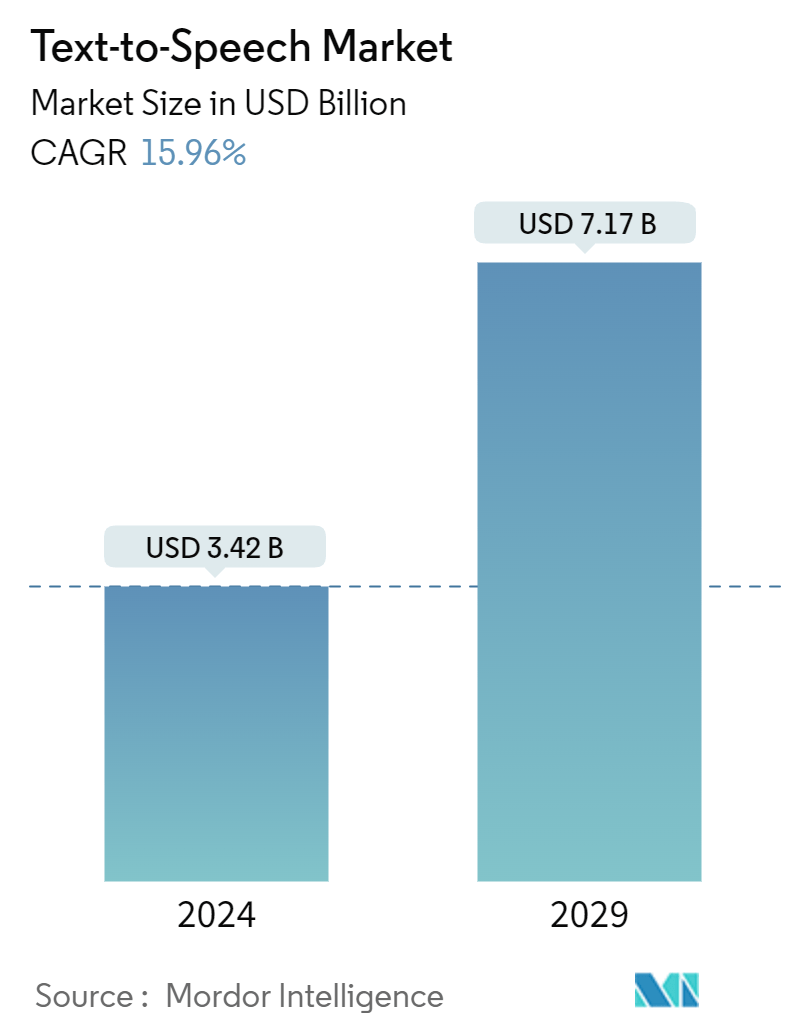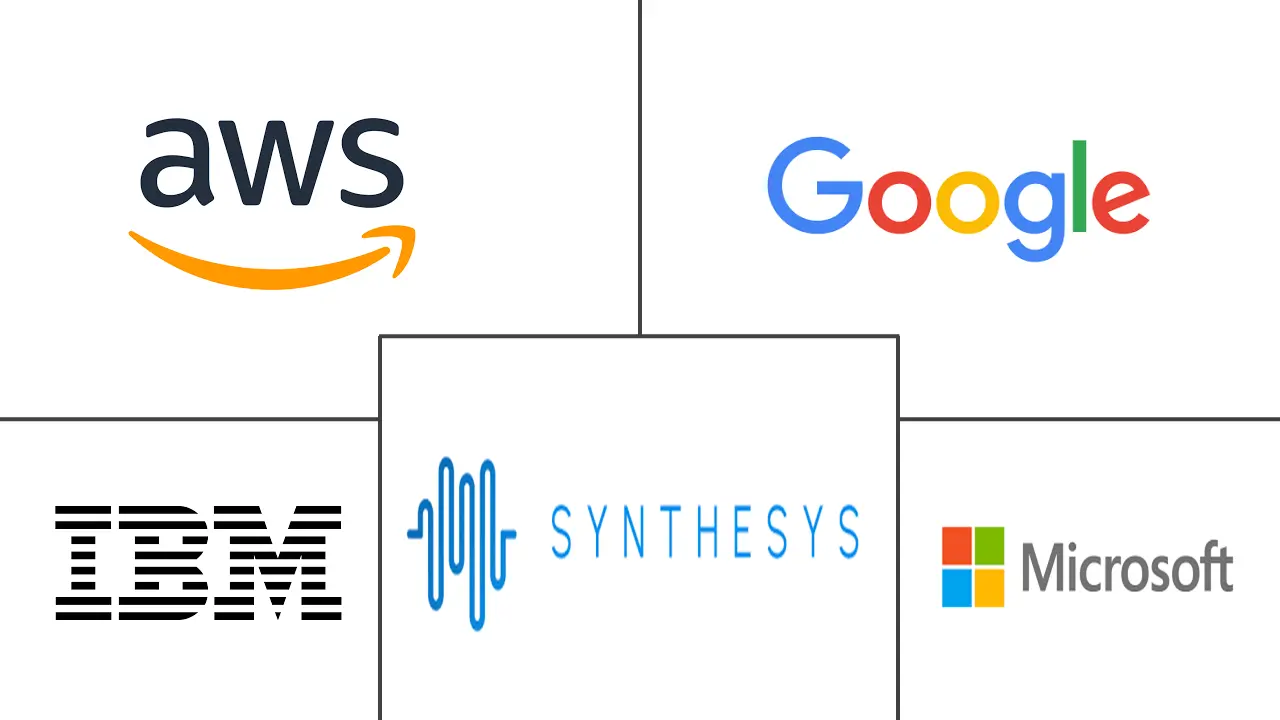Market Size of Text-to-Speech Industry

| Study Period | 2019 - 2029 |
| Market Size (2024) | USD 3.42 Billion |
| Market Size (2029) | USD 7.17 Billion |
| CAGR (2024 - 2029) | 15.96 % |
| Fastest Growing Market | Asia Pacific |
| Largest Market | North America |
| Market Concentration | Medium |
Major Players
*Disclaimer: Major Players sorted in no particular order |
Text-to-Speech Market Analysis
The Text-to-Speech Market size is estimated at USD 3.42 billion in 2024, and is expected to reach USD 7.17 billion by 2029, growing at a CAGR of 15.96% during the forecast period (2024-2029).
Text-to-speech solutions make communication more accessible to people with speech or reading disabilities, such as visual impairments, dyslexia, or other difficulties, by converting text into audio format, supporting the market growth.
- These solutions have the feature of providing multiple language audio output, helping businesses to expand globally by increasing their communication ability. For instance, companies can implement solutions to convert their written content into many spoken languages, making communicating with customers and employees worldwide easier.
- In addition, the text-to-speech solution can make businesses more accessible to a broader audience and even deliver regional accents and dialects for better customer engagement, driving the market adoption of speech-to-text solutions.
- Text-to-speech solutions can be used for educational technology, and teachers have been implementing them in their classes, LMS, webinars, and e-learning, to improve students' overall learning experience and help auditory learners retain information better.
- Additionally, market vendors, such as Speechify, have developed a solution to provide text-to-speech tools that work in numerous different languages, and there are plenty of customization options for struggling readers to adjust the sound, which is helping the market growth because implementing the solution the e-learning platform can generate audible content with ease.
- The broad application of text-to-speech solutions in healthcare to increase the efficiencies of medical education and research is fueling the adoption of the market during the forecast period. For instance, in February 2023, Laerdal Medical, a world-leading healthcare provider of cardiopulmonary resuscitation (CPR) manikins and other lifesaving technology, medical training, and resources, has planned to invest in artificial intelligence and machine learning, including Azure Text to Speech, to help save 1 million lives annually by 2030. Laerdal's 3D virtual training simulator for healthcare students and providers would use Azure AI text-to-speech to provide an immersive experience that simulates the real-life interactions between patients and providers.
- However, one of the most common issues with text-to-speech (TTS) is that the voices sound robotic and unnatural, which may not be an engaging experience for listeners due to the solutions' lack of the ability to mimic the natural inflection and tonality of human speech, which can be a market challenge because by delivering a same pitch for all texts, it can create a gap in the communications.
Text-to-Speech Industry Segmentation
Text-to-speech solutions include software and services which use Text-to-speech technology to transform written text into audio format with a human-like voice. It consists of software-based tools based on artificial intelligence (AI) with natural language process (NLP) and machine learning (ML) algorithms that can be installed on various digital devices, smartphones, and computers, allowing books, Word or Pages documents, and websites to be read aloud.
The text-to-speech market is segmented by component (software, services), deployment mode (cloud-based, on-premise), language (English, Spanish, Hindi, Chinese), and geography (North America, Europe, Asia-pacific, Latin America, Middle East & Africa).
The market sizes and forecasts are provided in terms of value in USD for all the above segments.
| By Component | |
| Software | |
| Services |
| By Deployment Mode | |
| Cloud-Based | |
| On-Premise |
| By Language | |
| English | |
| Spanish | |
| Hindi | |
| Chinese | |
| Other Languages |
| By Geography*** | |
| North America | |
| Europe | |
| Asia | |
| Australia and New Zealand | |
| Latin America | |
| Middle East and Africa |
Text-to-Speech Market Size Summary
The text-to-speech market is poised for significant growth, driven by its ability to enhance communication accessibility and support global business expansion. These solutions are particularly beneficial for individuals with speech or reading disabilities, such as visual impairments and dyslexia, by converting text into audio format. The capability to provide audio output in multiple languages enables businesses to communicate more effectively with a global audience, breaking down language barriers and fostering better customer engagement. This technology is increasingly being integrated into various sectors, including education and healthcare, where it is used to improve learning experiences and streamline medical training. The adoption of text-to-speech solutions is further bolstered by advancements in AI and machine learning, which are enhancing the naturalness and personalization of synthesized speech.
In North America, the growth of e-learning platforms and the rising popularity of audiobooks are creating substantial opportunities for the text-to-speech market. The integration of TTS solutions in educational settings is making learning more engaging and accessible, while the demand for audiobooks is driving the need for efficient text-to-audio conversion technologies. Additionally, businesses are leveraging TTS solutions for marketing purposes, creating engaging content quickly and cost-effectively. The market is semi-consolidated, with major players like IBM, Amazon, Google, and Microsoft leading the charge through innovations and strategic partnerships. These companies are focusing on enhancing their offerings to capture a larger market share, indicating a competitive landscape with ongoing advancements in TTS technology.
Text-to-Speech Market Market Size - Table of Contents
-
1. MARKET INSIGHTS
-
1.1 Market Overview
-
1.2 Industry Attractiveness - Porter's Five Forces Analysis
-
1.2.1 Bargaining Power of Buyers
-
1.2.2 Bargaining Power of Suppliers
-
1.2.3 Threat of New Entrants
-
1.2.4 Threat of Substitutes
-
1.2.5 Intensity of Competitive Rivalry
-
-
1.3 Industry Value Chain Analysis
-
1.4 Assessment of the Impact of COVID-19 on the Market
-
-
2. MARKET SEGMENTATION
-
2.1 By Component
-
2.1.1 Software
-
2.1.2 Services
-
-
2.2 By Deployment Mode
-
2.2.1 Cloud-Based
-
2.2.2 On-Premise
-
-
2.3 By Language
-
2.3.1 English
-
2.3.2 Spanish
-
2.3.3 Hindi
-
2.3.4 Chinese
-
2.3.5 Other Languages
-
-
2.4 By Geography***
-
2.4.1 North America
-
2.4.2 Europe
-
2.4.3 Asia
-
2.4.4 Australia and New Zealand
-
2.4.5 Latin America
-
2.4.6 Middle East and Africa
-
-
Text-to-Speech Market Market Size FAQs
How big is the Text-to-Speech Market?
The Text-to-Speech Market size is expected to reach USD 3.42 billion in 2024 and grow at a CAGR of 15.96% to reach USD 7.17 billion by 2029.
What is the current Text-to-Speech Market size?
In 2024, the Text-to-Speech Market size is expected to reach USD 3.42 billion.

